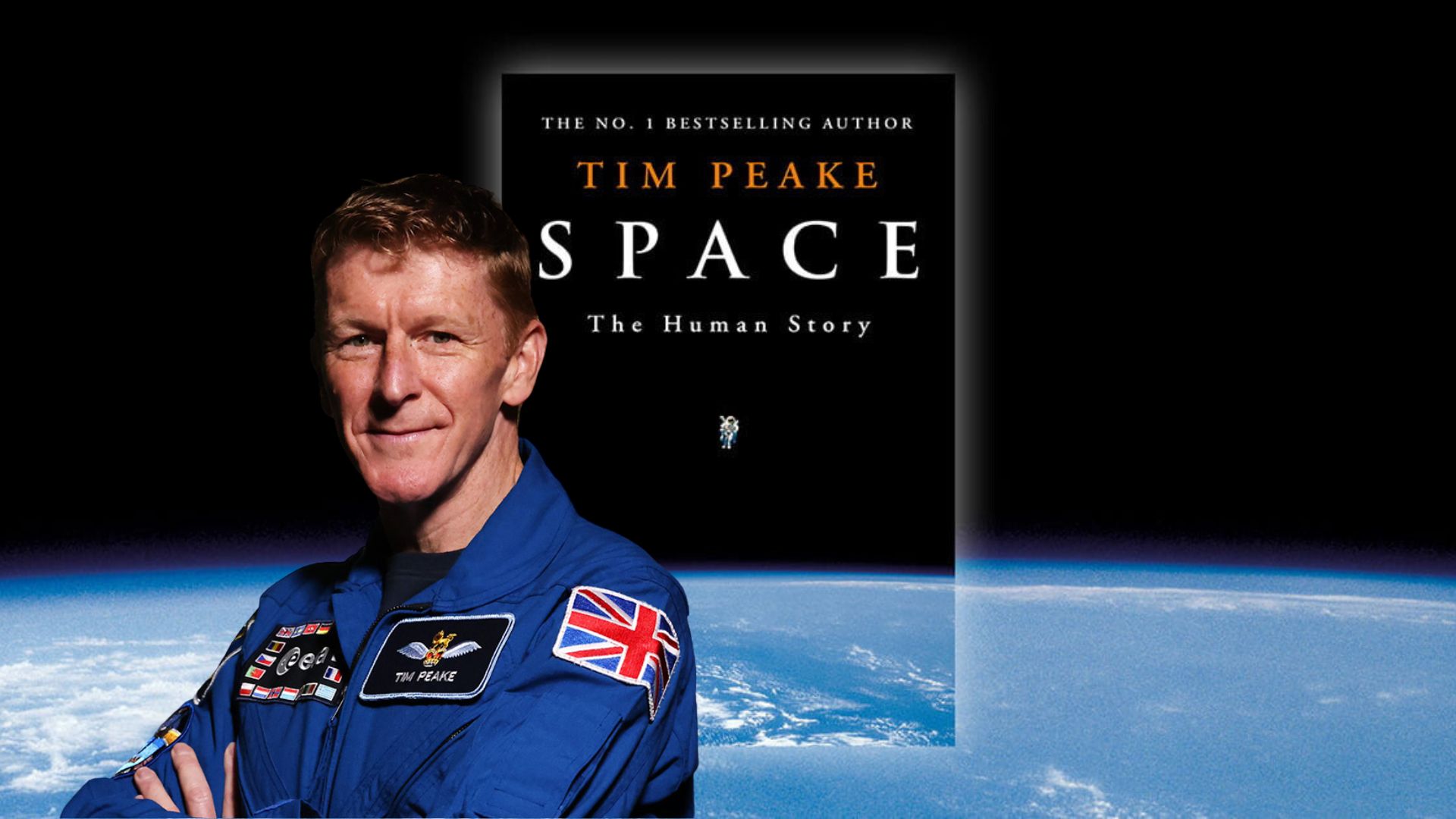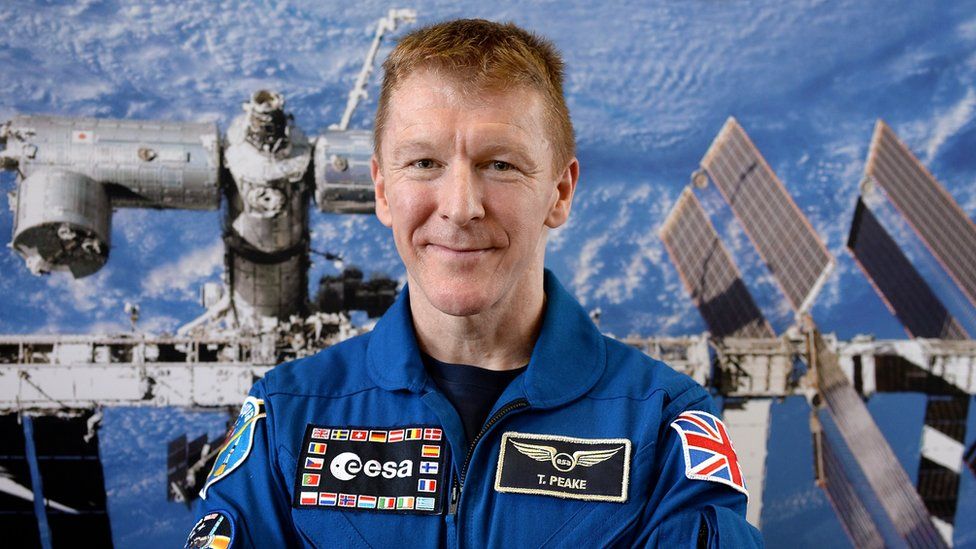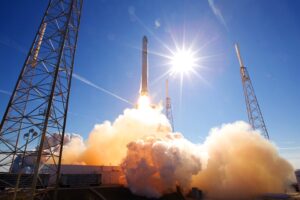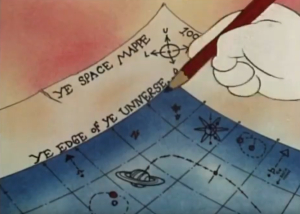Tim Peake “Space: the Human Story” – a journey into the lives that shaped astronautics
25th Jan 2024
“Space: the Human Story” is a recent book by the beloved British astronaut and bestselling author Tim Peake. It is “an inspirational human history of space travel, from the Apollo missions to our future forays to Mars” for everyone! Let’s discover what it is about!
Imagine finding yourself behind the scenes of space flights from their very beginnings to the present day. You have a unique opportunity to witness the formation of NASA and the preparation for the first human landing on the Moon. In a matter of seconds, you find yourself in the two leading countries that competed for supremacy in space over 40 years – the USA and the Soviet Union – observing the training of the first astronauts. In Space: the Human Story witness an astronaut’s evolution from a military pilot to a scientist who becomes a pioneer in the inhospitable environment of space – conquering it!
A great journey through the 50 years of space flights
Picture this journey as a direct path with crucial milestones in astronautics: the meticulous selection of the first team to leave Earth, the first person in space, the first person to step on the Moon, the first woman in space, the first unsuccessful mission, the only team that perished beyond Earth’s atmosphere, the first photograph of Earth from space. Dig deeper: between the well-known space events covered by the media, you can unveil what happened parallelly and was an integral part of the history of space flights. That’s what reading “Space: the Human Story” does.
Astronauts are not strangers to everything earthly
How were the first astronauts selected when the criteria were unknown? What does an astronaut feel at a press conference with all eyes on them? How do astronauts interact with their spouses and children while constantly on the training ground? What’s the taste of astronauts’ food? What goes through the mind of someone ascending into space on a giant rocket, facing numerous risks, including the possibility of not returning to Earth? How were critical decisions made when something went wrong, and a person’s life in a spacesuit depended on a pile of sensors and wires on the spacecraft?
Why can’t a robot ever replace a human in space, and why is this crucial for future Moon and Mars missions? It’s quite batch of hefty questions. Now, picture yourself being guided by an experienced astronaut who knows all the intricacies of space flights.
Lucky for you, he’s also a psychologist who understands that an astronaut is, above all, human. And he narrates not a dry history but the story of people familiar with everything earthly.
Great news: all of this is encapsulated in Tim Peake’s book “Space: the Human Story”!

Tim Peake. Image Credit: BBC.
A book for newcomers to space themes
If you’re a newcomer to the realm of space exploration, “Space: the Human Story” will captivate you with its clear chronological structure, eliminating the need to search Google for the history of astronautics; just reading this book will suffice.
How did the idea of space flights originate?
Tim Peake begins with the very idea of sending humans into space, narrating when and why NASA was formed. He meticulously explains the selection process of the first astronauts, all of whom were military pilots because individuals in this profession possessed the necessary training to endure the anticipated stresses in space, as well as the experience to handle unforeseen circumstances.
American vs USSR space flights: an objective comparison
In this book, you get a comprehensive understanding of the purpose behind it all. It’s fascinating to read how the author occasionally diverges from chronology, comparing similar events, such as the behaviour of Glenn and Gagarin in an extreme situation when issues arose with the capsule during Earth re-entry. Using specific personalities as a foundation, Tim Peake simultaneously compares different approaches to the training and safety of astronauts in the United States and the Soviet Union. For instance, where Americans meticulously checked their astronauts’ equipment and suits, a process that objectively took more time, the Russians took certain risks. “Among the many secrets of the success of the early Soviet space programme was a willingness to cut the occasional corner where it was felt expedient to do so. For instance, when Voskhod 1 flew, in October 1964,” they squashed the crew into a capsule designed for two. In order to make room for one more cosmonaut, the decision was taken to leave behind pressurized spacesuits, a risky move.
The symbolism of the first step on the Moon
Such descriptions do not appear biased towards either country, as the author primarily focuses on the personal qualities of astronauts, using technical details as background. Tim Peake refers to some of his heroes multiple times, like Neil Armstrong, the first person on the Moon. It was intriguing to read about the backstage decisions regarding who would be the first to step onto the Moon: Neil Armstrong or Buzz Aldrin. Here’s how he describes it: “The symbolism of the footprint on the surface – that was what the world was going to take away from this moment, not the planted leg print of the Eagle lander. Until Armstrong had descended that ladder and set his boot down in the dirt, the Moon had not been walked upon.”
And this was what it all boiled down to in the end, even after the unprecedented feats of rocketry and all the extraordinary technical innovation which had safely flown two astronauts to a destination a quarter of a million miles from home: the basic human act of walking. The whole history of human spaceflight had been tending determinedly towards this moment, and ultimately, when it arrived, it wasn’t going to be about machines and what machines did, it was going to be about humans and what humans did.
Dive into the full cycle of space flight!
In addition to the chronological timeline, Tim Peake structures his narrative as a complete cycle of spaceflight, with each chapter dedicated to a specific stage: Getting the Job, Getting Ready, Getting a Mission, Getting Off the Ground, Getting the Job Done, Getting Out, Getting Home. For each chapter, he selects a mission, an astronaut, and a situation that vividly illustrates each stage. I found it fascinating to learn from the “Getting Out” chapter about the first all-woman spacewalk and how Svitlana Savitskaya became the first woman to venture into space.
“In 1984, thirty-five years before Koch and Meir climbed out together, Savitskaya became the first woman to haul herself out into the void, an act to which you might say she had been building all her life: by the time she was seventeen, Savitskaya had completed 450 parachute jumps and would go on to hold world records for stratosphere jumping, flinging herself out of planes from heights in excess of 14,000 meters.” The author manages to describe emotional aspects without unnecessary grandiosity, maintaining the accuracy of figures and facts – a true human story!
A book for experienced space enthusiasts as well!
If you’re already an experienced space enthusiast who can intricately recount details about each mission over these 50 years, this book will still captivate you. Among the facts and technical descriptions of the flights, you’ll also find nuanced insights into the workings of different teams. For instance, it was interesting to discover that astronaut candidates sometimes had disputes over things like lengthy and exhausting medical examinations or food they didn’t like. As known, astronaut food isn’t known for its variety.
A funny incident about astronauts’ food
Once, it was simply cubes of dehydrated and freeze-dried meals or paste-like mixtures that barely resembled our regular food. “During his pioneering orbit of the Earth in 1961, Yuri Gagarin consumed two tubes of meat paste and one tube of chocolate sauce – not exactly a feast.” The incident with the sandwich sneaked on board amused me. “It was Schirra, who bought the sandwich – corned beef on rye, no mustard, no pickle. And it was Schirra who helped John Young smuggle that sandwich, wrapped tightly in cellophane, into a pocket in Young’s spacesuit on the morning of the flight.” Such ingenuity was unacceptable, but it prompted changes in the astronauts’ menu, and later, as Tim Peake recalls, “The first thing I ate in space was a bacon sandwich. And unlike with John Young and Gus Grissom on Gemini 3, nobody had needed to smuggle it on board.”
Urgent questions about human stay in space
Among other things, the author occasionally delves into reflections, such as: can a person live in space, or can they only survive there? To be more precise: can a person live in space just like on Earth? For example, can one drink alcohol in space? How does a person change after experiencing space, and do their priorities and views on life change? Everyone who has done this has coped with this experience differently upon returning home. For some, it was a traumatic experience, for others, the opposite.
It’s not just about how you fly there – it’s also about how you return
For instance, “It was Alan Bean’s plausible contention that ‘everyone who went to the Moon came back more like they already were’.” On his return from Apollo 12, Bean spent a day in a shopping mall, eating ice cream and watching people go by, in what seemed to him a renewed state of wonder for the world and all it offered. He stated his opinion that there was nothing that could be seen through a telescope that was as beautiful as the Earth. ‘We’ve been given paradise to live in,’ he said. ‘I think about it every day.’” Here, it seems the author returns to the idea he expressed at the beginning of his book: no matter how much you train, no guarantees you will fly to space; it depends on you. The same goes for the return: how you process this experience depends on the individual.
Why is space about humans?
It can’t be denied that each spaceflight is a collective achievement of humanity, involving all scientists, engineers, and others responsible for it. At this point, the author reflects on how the role of an astronaut has changed over the years. “The new Moon explorers will be scientists, of course, in addition to being pilots.” “Space exploration in the twenty-first century is, first and foremost, a scientific endeavor, and we are on the brink of an era in which space can become a large part of the solution to the problems we so clearly have on Earth. If we seize this opportunity, space can be the laboratory for many of the transformational technologies that we’re going to need on our planet and a vital contributor in areas such as energy, medicine, nutrition, agriculture, robotics and clean tech,” he adds.
Indeed, the recent Axiom-3 mission, which recently headed into space to conduct crucial experiments in microgravity conditions, confirms this.
And the main question of the book, as for me is: Can a robot replace a human in space flights? Tim Peake gives a clear answer to this question: Where a robot would need three years to conduct important experiments, a person could handle it in one day.
“In space, humans frequently boast the upper hand, efficiency-wise.” And there will be an increased call for them to be communicators and educators – something which was no real consideration for the Mercury astronauts and which has only grown to be a component of the job relatively recently, during the ISS age.
This is why Tim Peake’s “Space the Human Story” is a “Human Story.”
Is ‘Space: the Human Story’ worth reading?
The book is definitely worth reading if you enjoy looking at things from a different perspective and want to know more than commonly known facts. For newcomers to space-related topics, the book will reveal many basic knowledge about space, such as the history of the famous photograph ‘Pale Blue Dot’ or who became the first teacher in space. These facts can be used in casual conversations with friends or on a date to impress your significant other with your knowledge.
On the other hand, Tim Peake’s work cannot be called a “coffee table book for space enthusiasts” because while it provides details of space missions, there are just enough of them to understand the overall context, and they serve to “highlight” the personalities of astronauts. However, for someone not interested in precise numbers and dates, there might be too many of these details, and one might want to scroll through them quickly. Although they still appear organic – as observations.
In any case, the book is a tribute to remarkable individuals who achieved the impossible. I don’t know of any other such heartfelt book that is not a dry chronicle but focuses on the fact that despite all their greatness, these people were, above all, human.
It becomes special to readers, at times, we sometimes don’t know how to act. Through the life stories of outstanding astronauts, you’ll feel that fears, uncertainties, and moments of vulnerability are natural elements of the journey through the unknown. This book becomes a kind of compass in the world of uncertainty, showing that even the most exceptional people don’t always have all the answers. They also overcome fears, seek their path, and sometimes make choices without a clear plan.
Just like these astronauts, a reader can find confidence and inspiration in reading about how they overcame challenges. The book not only reveals their significant achievements but also underscores that every step and every decision is part of the human experience. Perhaps, it is in acknowledging our own limitations that we find true strength and the will to overcome the challenges that await us on our journey.
Thus, we would call Tim Peake’s “Human Story” not only a source of knowledge about space but also a guide in the world of self-discovery and problem-solving, which is relevant for anyone.






Thank you for your comment! It will be visible on the site after moderation.